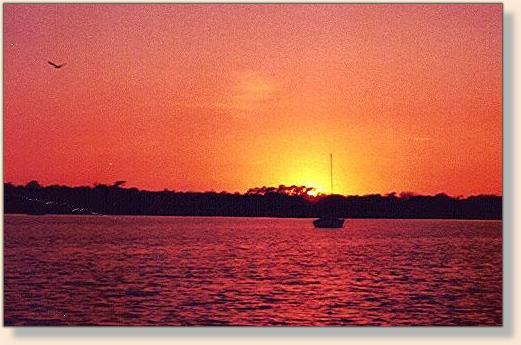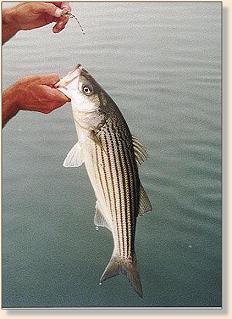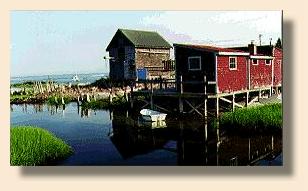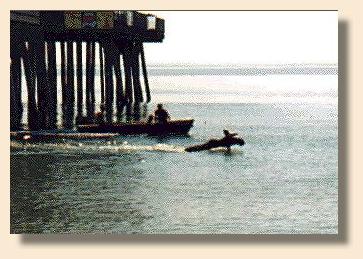Grass crunched under my feet as I walked the dunes to the beach.
You could hear the snap from sand and small stones breaking their
blades. In the twilight sand crabs scoured for food. Diving down
into their hideaways they scampered to escape from my presence.
Shore birds lined up like ducks at a shooting gallery, beacons
facing the onshore breeze. The seas were relatively quiet.
Flat water, we call it.

In a pool surrounded by rocks, sea urchins and a couple of baby
lobsters searched for morsels. The pool was decorated with lichens,
kelp, mussels, and other forms of aquatic vegetation. The bottom
reflected the sun's light as it dropped ever so slowly. I even
looked in and could see my reflection. The water was clean and
clear. Wild roses opened as the sun became one with the horizon.
They were everywhere, along the tops of the rocks and even along
a small creek that emptied from a salt marsh.
Even in the dim you could see the swaying of the grass tops as
they moved with the wind. Some of the seedpods would drop to
the ground. Natural re-forestation. How great. The only
disturbance came from my waders. Slung over my shoulders, they
made that annoying rubbing sound. My wading boots bounced on
their strings hung around by neck. Their clack on my chest
struck a cadence. They helped me keep pace and heighten my
wonder and enthusiasm.
Once over the dunes, I stopped, and placed a beach towel on
the sand. Rocks were readily available to serve as props to
keep down the towel's corners. I placed everything on the
towel and relaxed for a moment. I looked around in awe. I
looked up and saw birds floating upward, soaring and diving
with the currents. How beautiful this place was. The silence
except for the sound of birds and swishing from the water coming
in and going out, and the crabs doing their thing. I wondered
if the stripers were also moving in to sting some baitfish.
You could just make out this movement about twenty feet from
waters edge. And, then it hit me.

A loud crashing noise came from the surf, as little as it was.
Gulls took their positions and the bait propelled out of the water.
Tails were flapping, gulls were screaming, and the place erupted
with such a commotion, I was deliberately wakened by what was
happening. Stripers were moving along the shore and crashing
bait. Slapping bait with their tails, they made several runs
at this line. You could see their black stripes as they came
almost out of the water. Moving at explosive speed they sent
the bait clear out of the water. Easy pickings for the gulls
that just waited for the stunned fish to turn over sideways.
The stripers would come back, but they wouldn't have claim to
all the bait. Birds were diving everywhere. Then as quickly
as this started it was over, took about ten minutes.
Warren sat down and started putting on his waders over thick cotton
sweatpants and wool socks. He enjoyed fly-fishing for stripers
after sunset. As game commissioner for the estuary just south
of the Kennebec River, he was also concerned about activity from
moose. I wondered why the plural was the same. Shouldn't it be
'meese'? They sometimes frequent the beaches, mostly out of
curiosity. Late August and early September is mating season.
Moose will venture past the salt marshes and swim along a beach.
Moose are the largest members of the deer family and generally
not a threat to man. Although unpredictable, with males weighing
1200 pounds and females at 900 pounds, they have the right-of-way.
Their name comes from the Algonquian Indian name "moos." Alces
alces americanus for you Latin buffs. They live 15 to 25
years and eat mostly aquatic and marsh plants such as horsetails
and pondweed. Ever see that pouch hanging below their neck, it
is called a bell. So here we were in moos country, on a sandy beach,
commiserating with plants and animals and anticipating a hookup with
the formidable striped bass.
 Even with waders on the water felt cold. Warren thought it was about
sixty degrees. I couldn't say, but I wondered why my legs were
turning blue. He motioned for me to stop in about two feet of water.
We waited. Pulling off thirty feet of line into my stripping basket,
I got ready. You don't have much time when stripers start their
run along the beach. One of the most endearing qualities of these
fish is their feeding in shallow water. It puts most average casters
in range of some down right fun. A thirty-foot cast can have you on
a striper in seconds.
Even with waders on the water felt cold. Warren thought it was about
sixty degrees. I couldn't say, but I wondered why my legs were
turning blue. He motioned for me to stop in about two feet of water.
We waited. Pulling off thirty feet of line into my stripping basket,
I got ready. You don't have much time when stripers start their
run along the beach. One of the most endearing qualities of these
fish is their feeding in shallow water. It puts most average casters
in range of some down right fun. A thirty-foot cast can have you on
a striper in seconds.
Warren signaled the arrival of the stripers. You could see the bait
flying out of the water and the constant tail slaps. A green sand
lance got the first hook up. The striper bent Warren's rod and
started spooling line as it made a dash for Nova Scotia. Typically
they'll make a run for open water but will turn back. When the line
goes slack, start reeling. My cast was longer than I wanted but still
made a hook up. The hair fly is becoming a universal bait imitation
here. And, to think I use it for Tarpon. Stripers love it. I had
a striper following the first one. I had this happen several times
with the tandem fly setup. Maybe he thought the first guy would get
sloppy. But it didn't happen. Line came off the spool like a rocket.
After two hookups I was ready to call it a night. Off in a kelp slick
I saw a huge striper's tail cut the water's surface. I cast and lead
him by about three or four feet. BAM! He picked up that fly and
shook it from side to side. He tail walked. And made a run for
the creek. Two hundred yards of line came off my reel in about
10 seconds. The spool was absolutely screaming. The fan of water
was zinging in an arc that looked like the prop blade when it comes
out of the water. I moved into deeper water, above my knees. My
10 wt DFR was bending under the stress and power of this fish.
Just as I was about to move back, I noticed a pier behind me and
heard the faint noise of a motor. I turned to my left and couldn't
believe my eyes.

"MOOSE! Back out of the water! Cut your leader!" Warren yelled.
I'm thinking what the '@@$$%^@!' is this. I've got the biggest
striper on my line. He's making a run and I have to cut the
leader. Is Warren out of his mind? I looked at the Moose. I
looked at the motor boat (what was he doing here anyway).
The moose looked really big.
I cut the line. I cut Wonderline. I cut 200 yards of gel spun
backing. I cut $80 line for a Moos. Adrenalin was at max power.
Even when the line went slack, my arms were burning. I slowly
backed out of the water and headed up the beach where Warren
stood with the camera. "Close call," he said. "We did well.
How about some refreshments?" Off we headed to Dole's Pub.
Practice catch and release and enjoy our great outdoors.
~ Doug
About Doug:
Capt. Doug Sinclair has relocated from New Smyrna Beach, Florida to
Grantsboro, NC. He specializes in fly-fishing and light tackle charters.
Doug charters the Coastal Carolina area of New Bern or Oriental.
Catch him on the web at
www.flyfishacademy.net or call him at (252) 745-3500.
Doug is also a Sponsor here on FAOL.
|





